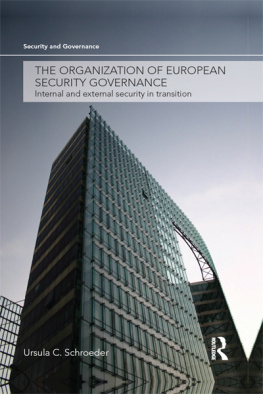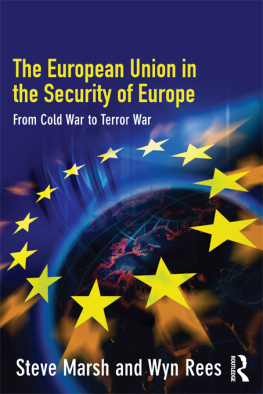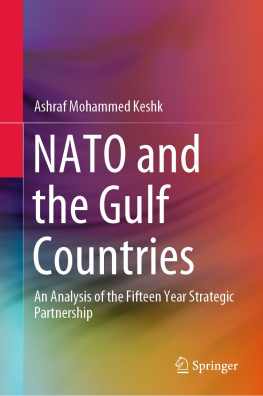1986 Stephen J.Flanagan and Fen Osler Hampson Croom Helm Ltd, Provident House, Burrell Row, Beckenham, Kent BR3 1AT
Croom Helm Australia Pty Ltd, Suite 4, 6th Floor, 6467 Kippax Street, Surry Hills, NSW 2010, Australia
British Library Cataloguing in Publication Data Securing Europes future: changing elements of European security.
1. Security, International 2. EuropeForeign relations1945 3. EuropeStrategic aspects I. Flanagan, Stephen J. II. Hampson, Fen Osler III. Harvard University. Centre for Science andInternational Affairs
327.1'16 JX1542
ISBN 0-203-99214-8 Master e-book ISBN
ISBN 0-7099-1086-X (Print Edition)
Auburn House Publishing Company, 14 Dedham Street, Dover Massachusetts 02030
This edition published in the Taylor & Francis e-Library, 2005.
To purchase your own copy of this or any of Taylor & Francis or Routledges collection of thousands of eBooks please go to www.eBookstore.tandf.co.uk.
Library of Congress Cataloging-in-Publication Data Securing Europes future.
A research volume from the Center for Science and International Affairs, Harvard University.
Includes index.
1. EuropeNational security. 2. North Atlantic Treaty Organization. I. Flanagan, Stephen J. II. Hampson, Fen Osler. III. John F.Kennedy School of Government. Center for Science and International Affairs.
UA646.S38 1986 355'.03304 8610879
ISBN 0-86569-135-5 (Print Edition) (Auburn House)
For Paul Doty, Director Emeritus of CSIA,
who provided opportunities for so many young scholars.
FOREWORD
Andrew J.Pierre
Senior Fellow, Council on Foreign Relations and Director of the Councils Project on European American Relations
European-American relations are beset by a paradox. On the one hand, the scope and intensity of trans-Atlantic contacts have never been greater. Direct-dial telephones, the telex machine, simultaneous publication of the same daily newspapers on the two sides of the Atlantic, satellite television that makes possible conversations linking individuals and audiences in Europe and Americaalong with the availability of jet transportation for millions of travelershave, in effect, created a communications bridge across the Atlantic.
On the other hand, the Atlantic is in some respects widening, and chasm rather than bridge may provide a better characterization. Divergences in interest and perspective have grown. Members of a new generation not molded by the experience of World War II, or even the immediate postwar years that led to the creation of NATO thirty-seven years ago, have moved into positions of responsibility. Increasingly, they are questioning many generally shared assumptionse.g., on the nature of the Soviet threat or on the relevance of the Third World to Western security. Europeans and Americans today seem to know less about each others societies, political systems, and foreign policy interests than a decade ago. Thus an incident such as the limited U.S. military strike against Libya in the Spring of 1986 can lead to knee-jerk recriminations based upon simplistic assumptions about American gun-slinging diplomacy and European spineless insularity without an adequate understanding of the overall political context, which in this case included European vulnerabilities to terrorist activities and American global perspectives in dealing with the terrorism problem.
Western Europe is increasingly becoming Europeanized while America is changing in such a manner as to heighten the saliency of its non-European culture and interests. In contrast to the first half of this century, and earlier, the probability of war within Eastern Europe has been reduced to near zero. Europeans no longer view the United States as a model society, one that they wish to emulate, as was the tendency in the early postwar decades. They are increasingly conscious of their common concerns, from high technology to the environment to detente, and this has led to marked expansion of intra-West European contacts in the private sector and a deepening of consultations among governments.
As for the United States, there has been a shift in the political center of gravity, away from the eastern and northern states that have traditionally been more Europe-oriented, toward the sunbelt states. The percentage of the American population living in the South and West has doubled since World War II. The proportion of Americans who do not look back upon a European origin blacks, Hispanics, and Asians has changed from one in ten in the 1940s to almost one in four in the 1980s. And American trade with the countries of the Pacific basin has, since 1983, been greater than trade with Western Europe.
These domestic changes have important foreign policy consequences, although it is difficult to specifically indentify or quantify them. A vote in the U.S. Congress on American troop levels in Europe or NATO burden-sharing will be affected by them. So also will West European policies on arms control or on East-West trade. Perhaps, above all, they are increasingly influencing how citizens think about foreign and security policynot an unimportant factor within the Western democracies where public debate has such a pivotal role.
What is significant about this book is that it presents the insights and judgments of a new generation of scholars in the field of European security studies. Its publication should lay to rest the erroneous but prevalent notion that there is no interest among younger scholars and analysts in the old issues of European security, military strategy, and arms control, or that it is only the less innovative academics that enter this field. As a group, the authors of this volume display the highest standards of scholarship: diligence in research, care in analysis and judgment, balance and creativity in conclusions.
But, in addition, these authors possess a keen sensitivity to the new trends affecting European security, many of which have their roots in the change of generations. The postwar consensus on Western defence has eroded significantly in recent years. In part, this was the result of the divisive debate over the deployment of cruise and Pershing II missiles, a NATO decision that had the unexpected effect of opening the Pandoras box of the Alliances nuclear dilemmas. The question is now being asked, as in the title of one of the chapters, is there an alternative to NATO? The role of nuclear weapons in the defense of Western Europe is being questioned, as in proposals for a no-first-use policy or for a nuclear-free-zone in Central Europe. There are a number of ideas being debated on ways to improve conventional defense so as to reduce reliance upon nuclear weapons. Some propose the use of emerging technologies and deep strike strategies, which call for the direct interdiction of Warsaw Pact rear echelons, and other very different proposals suggest a nonprovocative defense based upon the greater use of militias and reserve forces. And, of course, there is President Reagans Strategic Defense Initiative, which raises the most fundamental questions about Europes dependence upon Americas nuclear guarantee. All of these are highly controversial, and all are well analyzed and discussed in the pages that follow.
What emerges from this book about European security as a field of study for the decade or two ahead? First, one should note the growing importance of expertise. Understanding negotiations on intermediate nuclear forces or chemical arms control, or making recommendations on the revision of NATOs military doctrine or on a European SDI based on anti-tactical ballistic missile defenses, will require fairly detailed knowledge of the weapons systems and military strategies not only of the West but of the Soviet Union. The distinction between experts on NATO and on the Warsaw Pact should be reduced, with much more cross-fertilization. Part of the expertise, moreover, should include a history of how similar issues were addressed in the past. Too many of those who debated the placement of theater nuclear forces in the early 1980s, for example, were ignorant of the lessons to be drawn from the controversy over the multilateral nuclear force (MLF) two decades earlier.












